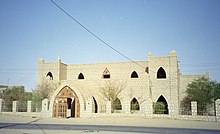Institut des hautes études et de recherches islamiques Ahmed Baba
The Institut des hautes études et de recherches islamiques Ahmed Baba (short: IHERI-AB) is an Islamic research center and library in the Republic of Mali , based in the oasis city of Timbuktu . It is subordinate to the Ministry of Higher Education in Bamako .
history
The center was founded in 1973 under the name "Center de documentation et de recherche Ahmed Baba", with funding from Islamic states, mainly from Kuwait . It was named after the scholar Ahmad Baba al-Massufi , who died in 1627 . The current director of the institute is Mohammed Gallah Dicko.
The current building was designed by a South African architect on behalf of South Africa and opened in 2009. The construction costs were named in newspaper reports at 5.8 million euros. It has an area of around 4600 m² and has air conditioning, which ensures that the historical manuscripts are properly preserved, and a fire extinguishing system. Another building dates from the 1970s. Acid-free cardboard boxes are produced in an in-house bookbindery. Around 30,000 manuscripts are stored in the institute. An even larger number of manuscripts (estimated to be over 200,000) are preserved by families in Timbuktu.
Most of the manuscripts date from the 13th to 16th centuries (for example from the traditional city mosques ). Most of the manuscripts are in Arabic , some in local languages such as Fulfulde , Songhai , Tamashek and Bamanankan , and others in Turkish and Hebrew . The majority of the non-Arabic texts use Arabic script, they are referred to as Adschami literature. They describe topics in medicine, biology, mathematics, alchemy , astronomy, poetry, history, literature and Islamic law . The oldest dated document is from 1204.
Arson
When French troops captured Timbuktu airport on January 28, 2013, the fleeing Islamist rebels of the Ansar ad-Din group , who had for their part protected the institute's buildings from looting since April 2012, set fire to the library. The digitization of the manuscripts, supported by UNESCO , had only started a few days earlier. How many documents could already be scanned in the three weeks is unknown, as is the condition of the 4200 missing manuscripts. According to newspaper reports, the majority of the manuscripts survived in 21 private libraries and storerooms in the capital Bamako. Volunteers working undercover succeeded in evacuating 2507 boxes from 32 collections with funding from the Netherlands and private Western and Arab foundations. Other manuscripts survived in the basement of the institute, unnoticed by the Islamists.
Web links
- Series of pictures model of the new system on archello.com
- Website Tombouctou Manuscripts (IHERI-AB) on tombouctoumanuscripts.org
Individual evidence
- ^ A b c Philippe Bernard: Les manuscrits de Tombouctou, victimes des islamistes et de la corruption. Malgré les millions de dollars dépensés, notamment par l'Unesco, la plupart des documents n'auraient pas été numérisés . In: Le Monde, January 29, 2013, accessed February 16, 2017.
- ^ Timbuktu library - a treasure house of centuries of Malian history on theguardian.com, accessed August 9, 2013.
- ↑ a b Markus M. Haefliger: The Rescue of the Manuscripts from Timbuktu - A conspiratorial community of librarians and archivists protects a historical treasure from access by Islamists . In: Neue Zürcher Zeitung . No. 137 . Zurich July 17, 2013, p. 35 .
- ↑ Rebels set fire to valuable library newspaper report from January 28 on derstandard.at, accessed August 9, 2013.
- ↑ Archaeologik (January 30, 2013): Tricked - Timbuktu manuscripts were hidden in time on archaeologik.blogspot.de, accessed August 9, 2013.
Coordinates: 16 ° 46 ′ 36.6 ″ N , 3 ° 0 ′ 20.9 ″ W.

